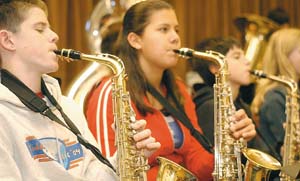Although the number of qualified teachers in California has
increased slightly during the past year, a shortage of teachers
exists throughout the state and San Benito County and is expected
to worsen in the coming years, according to a recent study.
Although the number of qualified teachers in California has increased slightly during the past year, a shortage of teachers exists throughout the state and San Benito County and is expected to worsen in the coming years, according to a recent study.
The study by the Center for the Future of Teaching and Learning also revealed students who have failed the high school exit exam are more likely to be taught by uncredentialed teachers.
At San Benito High School, where 51.2 percent of the class of 2004 had passed the math portion of the exit exam and 72.9 percent had passed the English-language arts portion, 87 percent of the high school’s teachers have a credential while 7 percent have emergency credentials.
California’s high school class of 2004 will be the first graduating class that will be required to pass the state exit exam in order to graduate.
According to SBHS Superintendent Dick Lowry, the high school has a shortage of of math and special education teachers.
“In recent years, it’s been getting impacted in every area, but particularly in those two areas (math and special education), Lowry said. “Although we’ve been pretty fortunate, and we’ve historically had few teachers on emergency credentials.”
Statewide, where 21 percent of teachers lacked a full credential, at least 75 percent of sophomores failed the math portion of the exit exam, according to the study. For schools that had only 9 percent of its teachers uncredentialed, less than 50 percent of sophomores failed the math portion.
In San Benito County, the teaching shortage diminished slightly last year then in previous years, where educators recruited out of state as well as in state.
“The economic downturn had a great impact on the number of available teachers,” County Superintendent of Schools Tim Foley said. “People are leaving the private sector to enter a career that offers stability and personal fulfillment.”
Also, an internship program in San Benito County is being offered to bring new teachers into schools.
The internship replaces the emergency credential program and makes it easier to become teachers by paying prospects to go through a 14-month supervised teaching environment. After 14 months, a teaching credential is issued.
About 42,000 of the state’s 290,000 teachers are working on emergency permits, as interns or in a pre-intern program, according to the study.
About 14 percent of the state’s teachers are not credentialed, and many of them are teaching in low performing schools, said Margaret Gaston, of the Center for the Future of Teaching and Learning.
Because of the correlation between the number of credentialed teachers to the number of students who pass the exit exam officials from the center urged state lawmakers to implement a new federal law a year early for the state’s worst performing schools.
The law, part of President Bush’s No Child Left Behind Act, requires all schools to employ only fully credentialed teachers.
“Things are getting a bit better in ensuring that each child has a fully prepared teacher, but not quickly enough,” Gaston said. “We believe strongly in setting high standards for all students, but if the state is going to require students to achieve these standards, basic fairness requires that the state first assure students have adequate access to fully prepared and effective teachers.”
California has spent more on teacher recruitment in the past several years, which has resulted in a 20-percent increase in the number of credentials issued, the report found.
Yet, with Gov. Gray Davis proposing heavy cuts in education to battle a massive state deficit, recruitment programs may be eliminated.
One aspect of the impending cuts will probably be more qualified teachers seeking employment, Lowry said.
“With the budget cuts we will reduce out-of-state recruitment and focus on taking advantage of other districts and hope to find more applicants in state,” he said.
But with a generation of teachers reaching retirement age and an increasing number of students, California public schools will face a growing shortage of qualified teachers in the coming years, Gaston said.
The researchers predict that “in about 10 years, we’ll have about 65,000 teachers who aren’t fully prepared to teach,” Gaston said.







